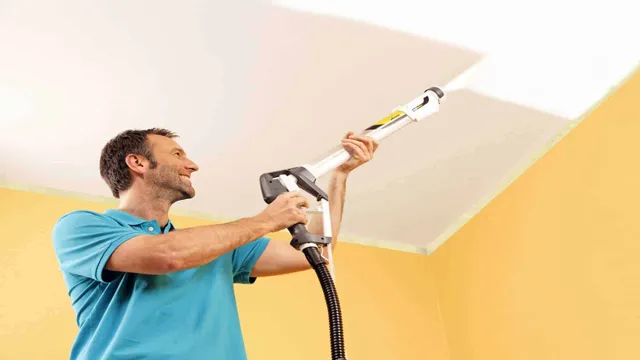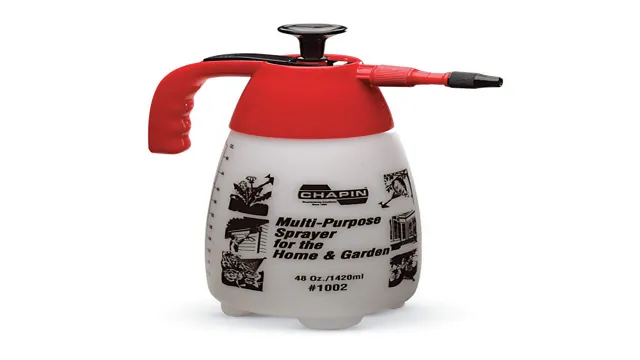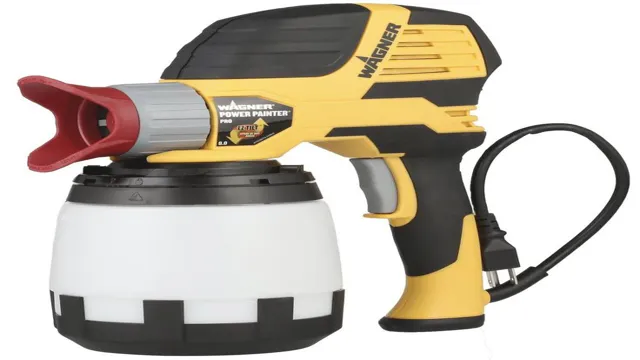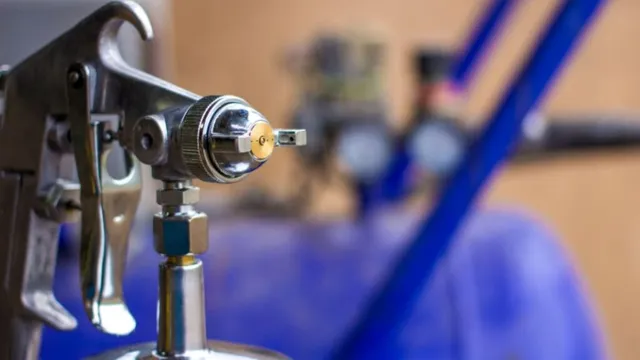Do It Yourself Paint Sprayer: Learn How to Spray Paint Like a Pro

Have you ever wanted to revamp your home with a fresh coat of paint but didn’t know where to start? Or maybe you’re a DIY enthusiast and are always looking for new projects to take on. Whatever the reason, a DIY paint sprayer could be the answer you’re looking for. A paint sprayer is a device that uses compressed air or high-pressure pumps to spray paint evenly and efficiently onto surfaces.
With a DIY paint sprayer, you can tackle any painting project with ease, whether it’s a small room or the entire exterior of your home. But with so many paint sprayers on the market, how do you choose the right one? Don’t worry, we’ve got you covered. In this ultimate guide, we’ll walk you through everything you need to know about DIY paint sprayers.
From the different types of sprayers available to the pros and cons of each, to tips and tricks on how to use them effectively, you’ll learn it all. So, get ready to unleash your inner DIY guru with our ultimate guide to DIY paint sprayers. Your home (and your wallet) will thank you for it!
Why Use a DIY Paint Sprayer?
Looking to give your home a fresh new look with a new coat of paint? Using a DIY paint sprayer can save you time, money, and provide a professional-quality finish. DIY paint sprayers come in different sizes and types, making it easy for anyone to tackle any painting project, big or small. One of the biggest advantages of using a paint sprayer is that it saves you from having to use brushes and rollers, ultimately reducing your painting time by a significant amount.
You can achieve a smooth and even finish with a paint sprayer, ensuring that every nook and cranny is covered. DIY paint sprayers are also versatile, making them perfect for painting walls, ceilings, and even furniture. With a little practice, you’ll be able to master the technique and transform your home’s look in no time.
So, why not try a do-it-yourself paint sprayer today and see the professional results for yourself?
Advantages Over Traditional Methods
If you’re looking to complete a painting project in your home or office, consider using a DIY paint sprayer. Not only will it save you time and money, but it also offers several advantages over traditional painting methods. For one, a paint sprayer can cover large surfaces quickly and evenly, without leaving streaks or lines.
Additionally, it can reach tight corners and hard-to-reach areas that a roller or brush cannot. With a paint sprayer, you also have better control over the amount of paint used, reducing waste, and minimizing the chances of accidentally applying too much. Finally, clean-up is a breeze, as sprayers only require a rinse with water or cleaning solution to be ready for their next use.
By using a DIY paint sprayer, you can tackle any painting project with ease and achieve professional-looking results without breaking the bank.

Cost-Efficiency and Time-Saving
Using a DIY paint sprayer can significantly save time and money while achieving a professional look. With a paint sprayer, you can effortlessly cover large surfaces quickly, which would take hours with a brush or roller. Moreover, the sprayer evenly coats surfaces, reducing the number of coats needed, thus reducing the amount of paint required.
This reduces the cost and time involved in preparing surfaces and applying paint. Besides, paint sprayers reduce cleanup time and labor. You do not need to spend time cleaning brushes or rollers, and there is less chance of dripping or splattering, reducing the number of touch-ups required.
In summary, using a DIY paint sprayer is an effective and efficient way to tackle painting projects, with the added advantage of producing a high-quality finish.
Perfect for Small-scale Projects
If you’re taking on a small-scale painting project, a DIY paint sprayer could be the perfect solution for you. Not only is it a cost-effective option, but it also allows for precise and efficient coverage. The most significant advantage of using a paint sprayer is the speed with which you can complete a project.
In comparison to a traditional brush and roller, a sprayer can cover more surface area in less time. This makes it an excellent option for those who want to get their project done quickly and with minimal effort. Plus, using a sprayer ensures a smooth and consistent finish that looks professional.
By opting for a DIY paint sprayer, you’re not only saving time and money, but you’re also achieving a high-quality finish that will make your project stand out. So why not give it a try?
Choosing the Right Paint Sprayer
Are you looking to take on some DIY home improvement projects? A paint sprayer can make the task of painting much more efficient and produce professional-looking results. But with so many options available, it can be overwhelming to choose the right one. If you’re a beginner, an airless paint sprayer may be the best choice.
They are easy to use and can cover large areas quickly. However, if you want more control over the paint flow, an HVLP paint sprayer may be a better option. These sprayers have a regulated flow and produce less overspray.
Consider the size of your project, the type of paint you will be using, and your budget when choosing a paint sprayer. With the right equipment, your painting project will be a breeze and you’ll be proud of the results. So why not give a do it yourself paint sprayer a try and see for yourself how much easier it can make your home improvement projects.
Types of DIY Paint Sprayers
Choosing the right paint sprayer can be a daunting task, especially since there are various types of DIY paint sprayers available in the market. Each type has its own unique features, advantages, and disadvantages, and it’s crucial to choose the right one based on the type of project you have. Airless paint sprayers are known for their speed and efficiency, making them perfect for large projects.
HVLP spray guns are best for precision work, providing excellent control for small surfaces and detail work. Meanwhile, handheld paint sprayers are ideal for quick touch-ups or smaller projects and offer portability and ease of use. It’s crucial to consider factors like the size of the project, the type of paint being used, and your level of experience when choosing the right paint sprayer for your DIY project.
Ultimately, whether you opt for an airless paint sprayer, HVLP spray gun, or handheld paint sprayer, ensure that it’s suitable for your specific needs and budget.
Factors to Consider When Choosing
When it comes to choosing the right paint sprayer, there are several factors to consider. First and foremost, think about the size of the project you’ll be working on. If you’re only planning on painting a small room, a handheld sprayer might do the trick.
However, if you’re painting the exterior of your house, you’ll need a more powerful sprayer. Another important factor to consider is the type of paint you’ll be using. Certain sprayers are better suited for thicker paints, while others work better with thinner ones.
Additionally, think about the level of control you’ll need over the spray pattern and flow. Some sprayers offer more adjustability than others, which can come in handy when working on intricate projects. Finally, think about your budget.
While you can find sprayers at a range of price points, keep in mind that a higher-end model may save you time and effort in the long run. Overall, take the time to research and compare different models before making your final decision.
Top DIY Paint Sprayers in the Market
When looking for a DIY paint sprayer, it’s essential to choose the right one for your needs. With so many options on the market, it can be overwhelming, but we’re here to help. The first thing to consider is the type of project you’ll be working on.
If you’re painting a large surface area, such as a wall or fence, a high-volume, low-pressure (HVLP) sprayer will work well. However, if you’re painting a smaller area, such as furniture, a handheld sprayer might be a better option. Another factor to consider is the type of paint you’ll be using.
Some sprayers work better with thicker paints, while others are better suited for thinner ones. Ultimately, it’s important to find a sprayer that is easy to use and comfortable to hold for an extended period of time. With the right sprayer, your DIY painting projects will be a breeze!
Preparing for Painting
If you’re planning on painting your home yourself, using a do-it-yourself paint sprayer can save you time and energy. But before you begin, there are a few steps you need to take to ensure your surfaces are prepared for painting. First, assess the areas you’ll be painting and remove any furniture or decorations that might get in the way.
Next, use a sandpaper or sander to smooth out any bumps or ridges on the surface. This will help your paint go on smoothly and evenly. Additionally, it’s crucial to wash your walls thoroughly with soap and water to remove any dirt or grease that might be present.
Allowing your surfaces to dry completely before painting is also essential for a professional-looking finish. Once everything is dry and prepped, you can begin painting with your do-it-yourself paint sprayer. Remember to practice on a small, inconspicuous area first and follow the manufacturer’s instructions for a flawless result.
With a little preparation and patience, you’ll be able to tackle your painting project like a pro using your do-it-yourself paint sprayer.
Properly Cleaning and Priming the Surface
Preparing the surface for painting is crucial to ensure that the end result looks great and lasts long. Before painting, it’s essential to clean the surface thoroughly and remove any dirt, grime, or grease. Use a mild detergent and warm water to clean the surface.
Rinse the surface with clean water and allow it to dry completely before moving to the next step. Once the surface is clean, you need to prime it. Priming helps the paint adhere better and makes it more durable.
It also ensures that the paint goes on smoothly and evenly. Choose a high-quality primer and apply it to the surface evenly. Allow the primer to dry completely before painting.
Properly cleaning and priming the surface will go a long way in ensuring that the paint job lasts for years to come.
Tips for Spraying Paint Properly
Preparing for Painting Before you start spraying paint on a surface, it is crucial to prepare it properly. First, clean the surface thoroughly to remove any dirt, dust, or debris. This ensures that the paint adheres well and results in a smooth finish.
Next, a primer coat is essential, especially if you are painting over a darker color or surface with stains. The primer provides a smooth base and helps the paint bond better. Sanding the surface with a fine-grit sandpaper also creates better adhesion and smoothness.
You can also use a tack cloth to ensure the surface is free of any loose particles. Finally, ensure the area is free of any obstructions or items that could interfere with your painting. A clean, clutter-free workspace provides the best environment for a successful outcome.
By taking these preparatory steps, you ensure a flawless finish and a long-lasting project that will provide maximum satisfaction.
Spraying Paint for Optimum Results
If you’re looking to do some DIY painting, using a paint sprayer can save you both time and effort, but it can be intimidating if you’ve never used one before. The key to achieving optimum results with your do-it-yourself paint sprayer is to start with the right equipment, including a quality sprayer and the right kind of paint specifically designed for sprayers. You’ll also want to ensure that your work area is clean and well-ventilated, with the walls or surfaces you’ll be spraying properly prepped and taped off.
Once you’re ready to start spraying, it’s important to maintain a steady rhythm and to keep the sprayer at the right distance from the surface for even coverage. With practice and attention to detail, your DIY paint job will turn out beautifully!
Setting Up the Paint Sprayer
When setting up your paint sprayer, it’s important to keep in mind that spraying paint requires a different approach than brushing or rolling. First things first, make sure you have all the necessary safety equipment, including a respirator mask and protective eyewear. Next, adjust the air pressure on your sprayer according to the type of paint you’ll be using.
It’s also a good idea to test-spray on a scrap piece of material to adjust the flow and pressure of the spray before starting on your actual project. To ensure smooth and even coverage, hold the sprayer at a consistent distance from the surface and use a sweeping motion as you spray. Avoid oversaturating the surface by applying multiple thin coats, rather than one thick layer.
With these tips in mind, you’ll be able to achieve optimum results when spraying paint with your paint sprayer.
Spraying Techniques for Different Surfaces
Spraying paint can be a tricky business, and different surfaces require different techniques. When it comes to achieving optimum results, there are a few things you should keep in mind. For starters, it’s important to choose the right type of paint for the surface you’ll be covering.
Some surfaces may require a primer or a specific type of paint that will adhere better. Once you’ve chosen your paint, it’s crucial to prepare the surface properly. This means cleaning, sanding, and removing any old paint or debris that may interfere with the new paint’s adhesion.
When it comes to spraying, technique is key. It’s important to maintain a consistent distance from the surface and apply the paint in even, sweeping motions. It’s also essential to use the correct nozzle size and adjust the pressure to achieve the desired finish.
Keep in mind that different surfaces may require different spray angles and techniques, so it’s always a good idea to test on a small area first. With the right preparation and technique, spraying paint can give you a professional-looking finish every time.
Final Thoughts and Recommendations
In conclusion, if you’re planning to paint your home or apartment, a do-it-yourself paint sprayer is an excellent option to consider. Not only is it more efficient and precise than traditional brushes or rollers, but it’s also less physically demanding and saves you time. However, before investing in a paint sprayer, it’s crucial to consider several factors, such as the type of paint you’ll be using, the size of the area you’re painting, and your level of experience.
Additionally, it’s essential to choose a high-quality paint sprayer that’s both affordable and reliable. Overall, a do-it-yourself paint sprayer is an excellent investment that can help you achieve professional-looking results and transform any living space.
Conclusion
In conclusion, using a do-it-yourself paint sprayer is the ultimate hack for anyone looking to achieve a professional-grade painting job without breaking the bank. With its easy-to-use mechanics and efficient delivery system, you’ll be able to tackle any project like a pro. Whether you’re a seasoned DIY-er or a novice looking to embrace the power of the sprayer, this handy tool is a game changer.
So, why settle for a lackluster paint job when you can unleash your inner Picasso with a do-it-yourself paint sprayer?”
FAQs
What is a do-it-yourself paint sprayer?
A do-it-yourself paint sprayer is a tool that allows you to apply paint quickly and evenly to a variety of surfaces.
How does a do-it-yourself paint sprayer work?
A do-it-yourself paint sprayer works by using high-pressure air to atomize the paint, creating a fine mist that can be sprayed onto surfaces.
What types of surfaces can a do-it-yourself paint sprayer be used on?
A do-it-yourself paint sprayer can be used on a variety of surfaces, including walls, ceilings, furniture, and metal surfaces.
How much does a do-it-yourself paint sprayer cost?
The cost of a do-it-yourself paint sprayer can vary depending on the brand and model, but typically ranges from $50 to $200.
What are the benefits of using a do-it-yourself paint sprayer?
The benefits of using a do-it-yourself paint sprayer include a faster and more even application of paint, which can save time and produce a more professional finish.
Are there any safety precautions I should take when using a do-it-yourself paint sprayer?
Yes, it is important to wear protective gear, such as goggles and a respirator, to prevent inhalation of fine paint particles. It is also important to follow the manufacturer’s instructions carefully and use the tool in a well-ventilated area.
Can a do-it-yourself paint sprayer be used for other coatings besides paint?
Yes, a do-it-yourself paint sprayer can be used for other coatings, such as sealers, stains, and varnishes. However, it is important to make sure that the sprayer is designed for the specific coating type.



